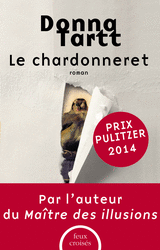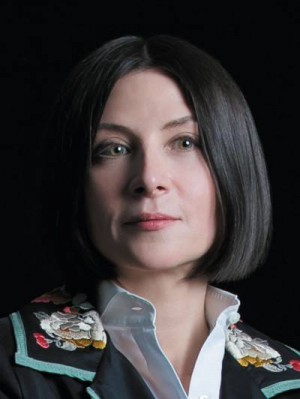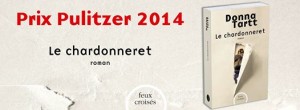 Bon, vous le savez sûrement aujourd’hui, Le Chardonneret, ou plutôt The Goldfinch, a reçu le prix Pulitzer 2014, catégorie « fiction ».
Bon, vous le savez sûrement aujourd’hui, Le Chardonneret, ou plutôt The Goldfinch, a reçu le prix Pulitzer 2014, catégorie « fiction ».
Autant vous dire que cela fait un drôle d’effet, même si je ne suis qu’indirectement concernée, car c’est l’original qui a reçu le prix, pas ma traduction.
Les effets ont été assez immédiats : la semaine suivante, Le Chardonneret avait gagné 5 places dans le palmarès de Datalib, et depuis il se maintient en dessous de la 30e place, ce qui n’est pas trop mal après quatre mois et 89 000 exemplaires vendus…
De mon coté – outre une centaine de recensions, dont une dizaine qui louaient ma traduction – j’ai eu droit à une déferlante d’interviews ou d’articles (enfin, six), ce qui me change de l’anonymat ordinaire. Cela « pourrait » aussi m’apporter du travail, deux nouvelles traductions se profilent que j’espère vous confirmer sous peu. Je regrouperai les informations à ce sujet lors d’une prochaine newsletter, dont un article particulièrement hilarant que j’oserai peut-être partager avec vous, qui sait…
Pour l’instant, ce qui m’intéresse c’est de vous confier enfin ce que je vous ai promis tout ce temps, à savoir les extraits périlleux – la scène de l’explosion, l’atelier d’ébénisterie et les paris sportifs – qui m’ont donné du fil à retordre, surtout les deux derniers – qui se retrouvent en démultiplié tout au long du livre… Pour le premier extrait, ce n’est pas le plus probant, désolée, mais je n’ai pas retrouvé celui que je cherchais… 🙁
Pour la solution, achetez donc Le Chardonneret !
Non, je plaisante, je vous la donnerai dans une prochaine newsletter bien sûr ! 🙂
La scène de l’explosion
 « I was in a ragged white cave. Swags and tatters dangled from the ceiling. The ground was tumbled and bucked‑up with heaps of a gray substance like moon rock, and blown about with broken glass and gravel and a hurricane of random trash, bricks and slag and papery stuff frosted with a thin ash like first frost. High overhead, a pair of lamps beamed through the dust like off-kilter car lights in fog, cock-eyed, one angled upward and the other rolled to the side and casting skewed shadows. My ears rang, and so did my body, an intensely disturbing sensation: bones, brain, heart all thrumming like a struck bell. Faintly, from somewhere far away, the mechanical shriek of alarms rang steady and impersonal. I could hardly tell if the noise was coming from inside me or outside me. There was a strong sense of being alone, in wintry deadness. Nothing made sense in any direction. In a cascade of grit, my hand on some not-quite-vertical surface, I stood, wincing at the pain in my head. The tilt of the space where I was had a deep, innate wrongness. On one side, smoke and dust hung in a still, blanketed layer. On the other, a mass of shredded materials slanted down in a tangle where the roof, or the ceiling, should have been. My jaw hurt… »
« I was in a ragged white cave. Swags and tatters dangled from the ceiling. The ground was tumbled and bucked‑up with heaps of a gray substance like moon rock, and blown about with broken glass and gravel and a hurricane of random trash, bricks and slag and papery stuff frosted with a thin ash like first frost. High overhead, a pair of lamps beamed through the dust like off-kilter car lights in fog, cock-eyed, one angled upward and the other rolled to the side and casting skewed shadows. My ears rang, and so did my body, an intensely disturbing sensation: bones, brain, heart all thrumming like a struck bell. Faintly, from somewhere far away, the mechanical shriek of alarms rang steady and impersonal. I could hardly tell if the noise was coming from inside me or outside me. There was a strong sense of being alone, in wintry deadness. Nothing made sense in any direction. In a cascade of grit, my hand on some not-quite-vertical surface, I stood, wincing at the pain in my head. The tilt of the space where I was had a deep, innate wrongness. On one side, smoke and dust hung in a still, blanketed layer. On the other, a mass of shredded materials slanted down in a tangle where the roof, or the ceiling, should have been. My jaw hurt… »
L’atelier d’ébénisterie…
« Auction houses all over the city called him, as well as private clients; he restored furniture for Sotheby’s, for Christie’s, for Tepper, for Doyle. After school, amidst the drowsy tick of the tall-case clocks, he taught me then pore and luster of different woods, their colors, the ripple and gloss of tiger maple and the frothed grain of burled walnut, their weights in my hand and even their different scents — “sometimes, when you’re not sure what you have, it’s easiest just to take a sniff” — spicy mahogany, dusty-smelling oak, black cherry with its characteristic tang and the flowery, amber-resin smell of rosewood. Saws and counter-sinks, rasps and rifflers, bent blades and spoon blades, braces and mitre – I learned about veneers and gilding, what a mortise and tenon was, the difference between ebonized wood and true ebony, between Newport and Connecticut and Philadelphia crest rails, how the blocky design and close-cropped top of one Chippendale bureau rendered it inferior to another bracket-foot of the same vintage with its fluted quarter columns and what he liked to call the “exalted” proportions of the drawer ratio. »
Vous avez dit paris sportifs ?
« You have to approach it like an investor. Not like a fan, not even like a gambler because the secret is, the better team usually wins the game and the linemaker is good at setting the number. Your linemaker has got limitations, though, as to public opinion. What he’s predicting is not who’s going to win but who the general public thinks is going to win. So that margin, between sentimental favorite and actual fact — fuck, see that receiver in the end zone, another big one for Pittsburgh right there, we need them to score now like we need a hole in the head — anyway, like I was saying, if I really sit down and do my homework as opposed to Joe Beefburger who picks his team by looking five minutes at the sports page? Who’s got the advantage? See, I’m not one of these saps that gets all starry-eyed about the Giants rain or shine — shit, your mother could have told you that. Scorpio is about control — that’s me. I’m competitive. Want to win at any price. That’s where my acting came from, back when I acted. Sun in Scorpio, Leo rising. All in my chart. Now you’re a Cancer, hermit crab, all secretive and up in your shell, completely different MO. It’s not bad, it’s not good, it’s just how it is. Anyway, whatever, I always take my lead from my defensive-offensive lines, but all the same it never hurts to pay attention to these transits and solar-arc progressions on game day. »
got limitations, though, as to public opinion. What he’s predicting is not who’s going to win but who the general public thinks is going to win. So that margin, between sentimental favorite and actual fact — fuck, see that receiver in the end zone, another big one for Pittsburgh right there, we need them to score now like we need a hole in the head — anyway, like I was saying, if I really sit down and do my homework as opposed to Joe Beefburger who picks his team by looking five minutes at the sports page? Who’s got the advantage? See, I’m not one of these saps that gets all starry-eyed about the Giants rain or shine — shit, your mother could have told you that. Scorpio is about control — that’s me. I’m competitive. Want to win at any price. That’s where my acting came from, back when I acted. Sun in Scorpio, Leo rising. All in my chart. Now you’re a Cancer, hermit crab, all secretive and up in your shell, completely different MO. It’s not bad, it’s not good, it’s just how it is. Anyway, whatever, I always take my lead from my defensive-offensive lines, but all the same it never hurts to pay attention to these transits and solar-arc progressions on game day. »
Où il apparaît que traduire le Pulitzer 2014, ce n’était donc pas de la tarte… 😉
Merci de ce commentaire londonien, cher Jean-Paul, et encore un énorme merci pour l’aide ès paris… 🙂
En effet, ce n’est pas du gâteau. En tout cas, bravo pour le résultat en français !